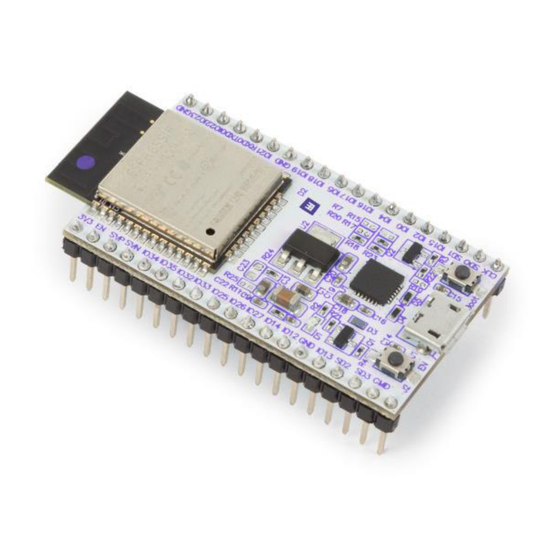
Table of Contents
Advertisement
Quick Links
Advertisement
Table of Contents

Summary of Contents for Whadda ESP32
- Page 1 USER MANUAL ESP32 DEVELOPMENT BOARD WPB109 whadda.com...
-
Page 2: Safety Instructions
If in doubt, contact your local waste disposal authorities. Thank you for choosing Whadda! Please read the manual thoroughly before bringing this device into service. If the device was damaged in transit, do not install or use it and contact your dealer. -
Page 3: Product Overview
ESP32, the upgraded cousin of the popular ESP8266. Like the ESP8266, the ESP32 is a WiFi-enabled microcontroller, but to that it adds support for Bluetooth low-energy (i.e BLE, BT4.0, Bluetooth Smart), and 28 I/O pins. The ESP32’s power and versatility makes it the ideal candidate to serve as the brains of your next IoT project. -
Page 4: Functional Overview
Functional overview Key Component Description ESP32-WROOM-32 A module with ESP32 at its core. EN Button Reset button Download button. Holding down Boot and then pressing EN initiates Boot Button Firmware Download mode for downloading firmware through the serial port. Converts USB into UART serial in order to... -
Page 5: Getting Started
, and hit “OK”. 3. Open the Boards Manager from Tools > Board menu and install the esp32 platform by putting ESP32 into the search field, selecting the most recent version of the esp32 core (by Espressif Systems), and clicking "Install". - Page 6 Uploading the first sketch to the board 4. Once the ESP32 core has been installed, open the tools menu and select the ESP32 Dev module board by going to: Tools > Board:"..." > ESP32 Arduino > ESP32 Dev Module 5. Connect the Whadda ESP32 module to your pc using a micro USB cable. Open the tools menu again and check if a new serial port has been added to the port list and select it (Tools >...
- Page 7 6. Check that the following settings have been selected in the tools board menu: 7. Select an example sketch from the “Examples for ESP32 Dev Module” in File > Examples. We recommend to run the example called “GetChipID” as a starting point, which can be found under File >...
- Page 8 9. Open the serial monitor ( ), and check that the baudrate is set to 115200 baud: 10. Press the Reset/EN button, debug messages should start appearing on the serial monitor, together with the Chip ID (If the GetChipID example was uploaded).
- Page 9 Having trouble? Restart the Arduino IDE and reconnect the ESP32 board. You can check if the driver has been properly installed by checking Device manager on Windows under COM Ports to see if a Silicon Labs CP210x device is recognized. Under Mac OS you can run the command ls /dev/{tty,cu}.* in...
- Page 10 WiFi connection example The ESP32 really shines in applications where WiFi connectivity is required. The following example will harness this extra functionality by having the ESP module function as a basic webserver. 1. Open the Arduino IDE, and open the AdvancedWebServer example by going to File > Examples >...
- Page 11 3. Connect your ESP32 to your pc (if you haven’t already), and make sure that the correct board settings in the Tools menu are set and that the proper serial communication port has been selected. 4. Click the Upload button ( ), and monitor the info messages at the bottom.
- Page 12 Check that the WiFi network name and password have been set up correctly, and that the ESP32 is in range of your WiFi access point. The ESP32 has a relatively small antenna so it might have more difficulties to pick up the WiFi signal at a certain location than your PC.
- Page 13 7. Open our web browser and try to connect to the ESP32 by entering it’s ip addresses in the address bar. You should get a webpage that shows a randomly generated graph from the ESP32 What to do next with my Whadda ESP32 board? Check out some of the other ESP32 examples that come preloaded in the Arduino IDE.
- Page 14 Modifications and typographical errors reserved - © Velleman Group nv, Legen Heirweg 33 - 9890 Gavere WPB109-26082021.


Need help?
Do you have a question about the ESP32 and is the answer not in the manual?
Questions and answers